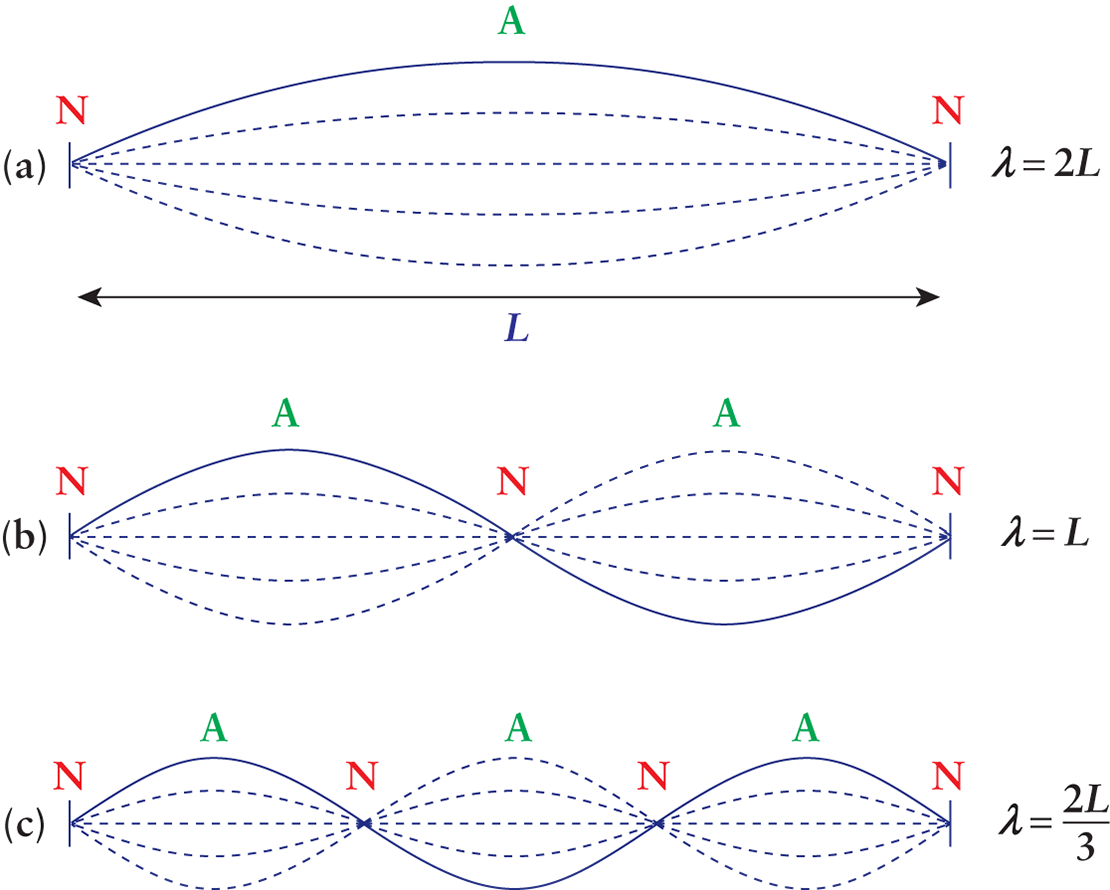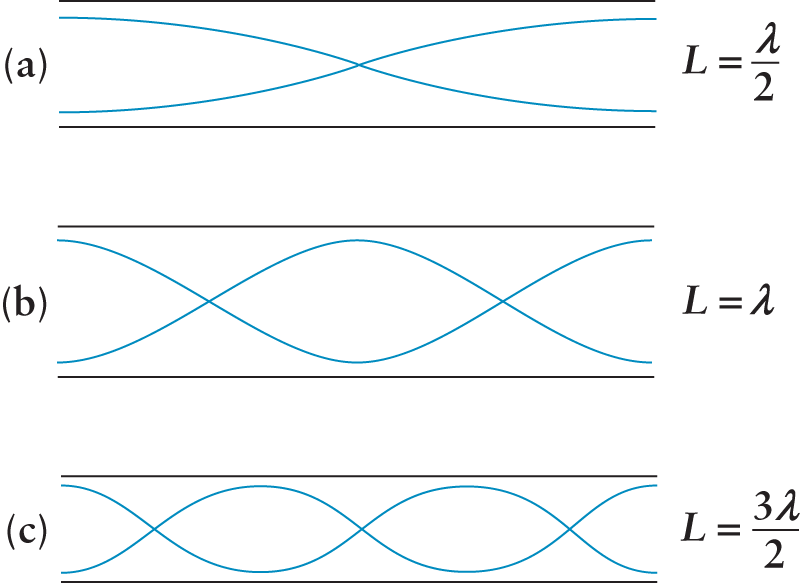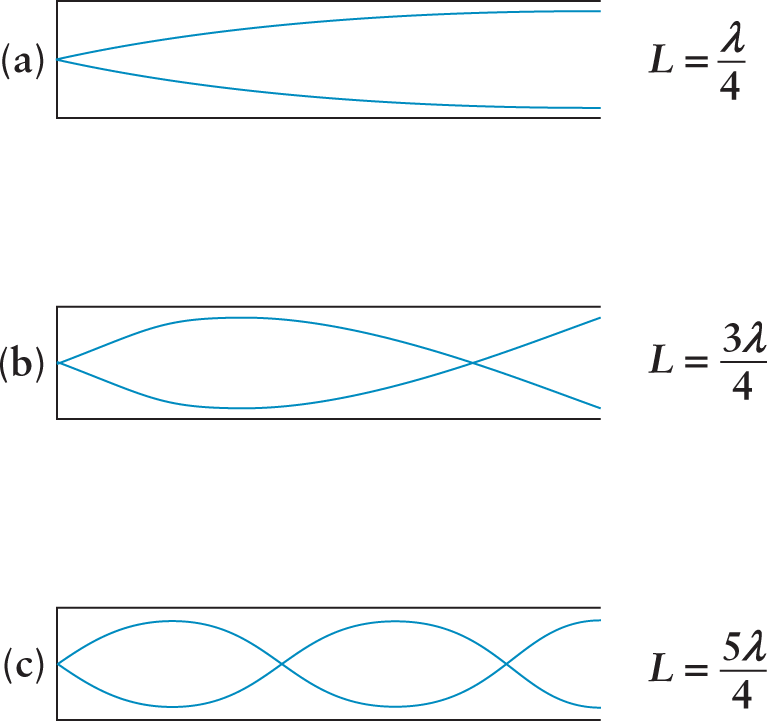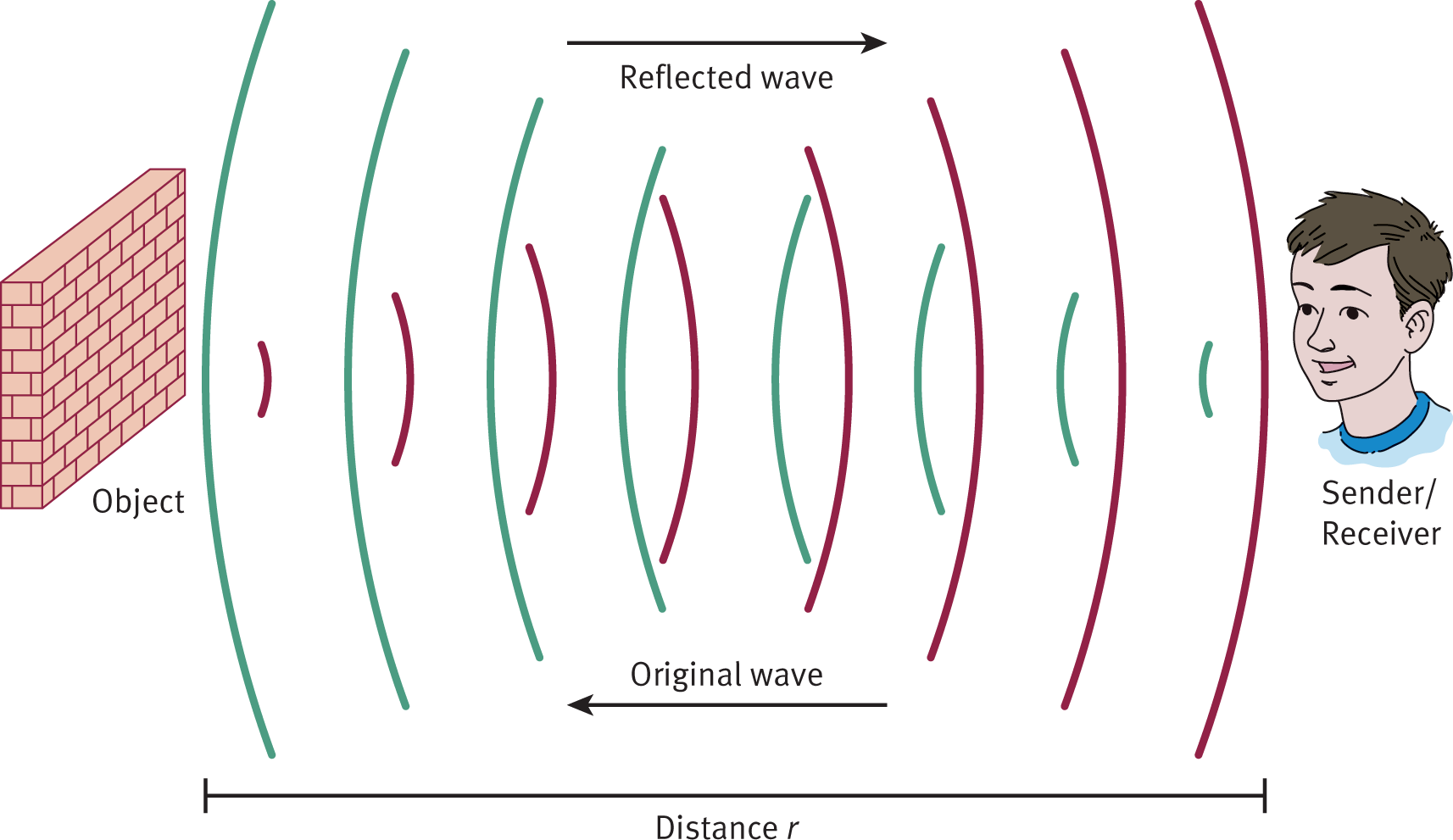
After Chapter 7.2, you will be able to:
Sound is a longitudinal wave transmitted by the oscillation of particles in a deformable medium. As such, sound can travel through solids, liquids, and gases, but cannot travel through a vacuum. The speed of sound is given by the equation
where B is the bulk modulus, a measure of the medium’s resistance to compression (B increases from gas to liquid to solid), and ρ is the density of the medium. Because the bulk modulus increases disproportionately
more than density as one goes from gas to liquid to solid, sound travels fastest through
a solid and slowest through a gas. The speed of sound in air at 20°C is approximately

The speed of sound is fastest in a solid with low density, and slowest in a very dense gas.
Sound is produced by the mechanical disturbance of particles in a material along the sound wave’s direction of propagation. Although the particles themselves do not travel along with the wave, they do vibrate or oscillate about an equilibrium position, which causes small regions of compression to alternate with small regions of rarefaction (decompression). These alternating regions of increased and decreased particle density travel through the material, allowing the sound wave to propagate.
Because sound involves vibration of material particles, the source of any sound is ultimately a mechanical vibration of some frequency. They can be produced by the vibration of solid objects or the vibration of fluids, including gases. Solid objects that can vibrate to produce musical sound include strings (on a piano, violin, guitar, and so on), metal (bells), or wood bars (xylophone or marimba). Vibration of air within certain objects, including all woodwinds and brass instruments, pipe organs, and even a soda bottle, can also create musical sound. The pitch (frequency) at which the air column within the instrument vibrates is determined by the length of the air column, which can be changed either by covering holes in the instrument or directly changing its length.
The human voice is no less a musical instrument than any of those listed above. Sound is created by passing air between the vocal cords, which are a pair of thin membranes stretched across the larynx. As the air moves past the cords, they vibrate like the double reed of an oboe or bassoon, causing the air to vibrate at the same frequency. The pitch of the sound is controlled by varying the tension of the cords. Adult male vocal cords are larger and thicker than those of adult females; thus, the male voice is typically lower in pitch.
We’ve discussed frequency as the rate at which a particle or wave completes a cycle. Our perception of the frequency of sound is called the pitch. Lower-frequency sounds have lower pitch, and higher-frequency sounds have higher pitch. On the MCAT, sound frequencies are usually within the normal range of human hearing, from 20 Hz to 20,000 Hz. Sound waves with frequencies below 20 Hz are called infrasonic waves, and those with frequencies above 20,000 Hz are called ultrasonic waves. Both dog whistles, which emit frequencies between 20 and 22 kHz, and medical ultrasound machines, which emit frequencies in excess of 2 GHz, are examples of ultrasonic waves.
We’ve all witnessed the Doppler effect: an ambulance or fire truck with its sirens blaring is quickly approaching from the other lane, and as it passes, one can hear a distinct drop in the pitch of the siren. This phenomenon affecting frequency is called the Doppler effect, which describes the difference between the actual frequency of a sound and its perceived frequency when the source of the sound and the sound’s detector are moving relative to one another. If the source and detector are moving toward each other, the perceived frequency, f′, is greater than the actual frequency, f. If the source and detector are moving away from each other, the perceived frequency is less than the actual frequency. This can be seen from the Doppler effect equation:
where f′ is the perceived frequency, f is the actual emitted frequency, ν is the speed of sound in the medium, νD is the speed of the detector, and νS is the speed of the source. Note the unusual signs in the equation. If memorized in this form, the upper sign should be used when the detector or source is moving toward the other object. The lower sign should be used when the detector or source is moving away from the other object.
The Doppler effect applies to all waves, including light. This means that if a source of light is moving toward the detector, the observed frequency will increase. This is called blue shift because blue is at the high-frequency end of the visible spectrum. If the source is moving away from the detector, the observed frequency will decrease, causing red shift. Light and electromagnetic waves are discussed in Chapter 8 of MCAT Physics and Math Review.
Sign convention in the Doppler equation:
This sign convention is usually the most confusing part of the Doppler effect equation, so let’s take a closer look. Imagine the situation presented earlier: you’re driving down the street when you hear an ambulance approaching from behind. In this scenario, you are the detector and the ambulance is the sound source. At this time, you would say that you are driving away from the ambulance; even though the ambulance is moving faster and getting closer to you, the direction in which you are driving is still away from the ambulance. By this logic, the lower sign (–) should be used in the numerator, which relates to the detector. The driver of the ambulance, on the other hand, would say that he is driving toward you. By this logic, the top sign (–) should be used in the denominator, which relates to the source. In this case, the Doppler effect equation would look like this:

Because νS > νD, we know that f′ > f.
Now imagine that the ambulance has passed you and continues to speed down the road. At this point, you would say that you are driving toward the ambulance (top sign in the numerator, +), even if you are not going as fast as it is. The ambulance driver would say that he is driving away from you (bottom sign in the denominator, +) and the corresponding Doppler effect equation would be:

Here, because νS > νD, f′ < f. This change in f′ from being greater than f to being less than f is perceived as a drop in pitch.
The Doppler effect can be visualized by considering the sound waves in front of a moving object as being compressed, while the sound waves behind the object are stretched out, as shown in Figure 7.5.

The Doppler effect can be used by animals through the process of echolocation. In echolocation, the animal emitting the sound (usually a dolphin or bat) serves as both the source and the detector of the sound. The sound bounces off of a surface and is reflected back to the animal. How long it takes for the sound to return, and the change in frequency of the sound, can be used to determine the position of objects in the environment and the speed at which they are moving.
In a special case of the Doppler effect, an object that is producing sound while traveling at or above the speed of sound allows wave fronts to build upon one another at the front of the object. This creates a much larger amplitude at that point. Because amplitude for sound waves is related to the degree of compression of the medium, this creates a large pressure differential or pressure gradient. This highly condensed wave front is called a shock wave, and it can cause physical disturbances as it passes through other objects. The passing of a shock wave creates very high pressure, followed by very low pressure, which is responsible for the phenomenon known as a sonic boom. Unlike its depiction in movies and television, a sonic boom can be heard any time that an object traveling at or faster than the speed of sound passes a detector, not just at the point that the speed of sound is exceeded (Mach 1). Once an object moves faster than the speed of sound, some of the effects of the shock wave are mitigated because all of the wave fronts will trail behind the object, destructively interfering with each other.
The loudness or volume of a sound is the way in which we perceive its intensity. Perception of loudness
is subjective, and depends not only on brain function, but also physical factors such
as obstruction of the ear canal, stiffening of the ossicles, or damage to cochlear
hair cells by exposure to loud noises or with age. Sound intensity, on the other hand,
is objectively measurable. Intensity is the average rate of energy transfer per area across a surface that is perpendicular
to the wave. In other words, intensity is the power transported per unit area. The
SI units of intensity are therefore watts per square meter
 . Intensity is calculated using the equation
. Intensity is calculated using the equation
where P is the power and A is the area. Rearranging this equation, we could consider that the power delivered across a surface, such as the tympanic membrane (eardrum), is equal to the product of the intensity I and the surface area A, assuming the intensity is uniformly distributed.
The amplitude of a sound wave and its intensity are also related to each other: intensity is proportional to the square of the amplitude. Therefore, doubling the amplitude produces a sound wave that has four times the intensity.
Intensity is also related to the distance from the source of the sound wave. As sound waves emanate outward from their source, it is as though the waves are pushing against the interior wall of an ever-expanding spherical balloon. Because the surface area of a sphere increases as a function of the square of the radius (A = 4πr2), sound waves transmit their power over larger and larger areas the farther from the source they travel. Intensity, therefore, is inversely proportional to the square of the distance from the source. For example, sound waves that have traveled 2 meters from their source have spread their energy out over a surface area that is four times larger than that for identical sound waves that have traveled 1 meter from their source.
The softest sound that the average human ear can hear has an intensity equal to about
 The mechanical disturbance associated with the threshold of hearing is remarkably
small—the displacement of air particles is on the order of one billionth of a centimeter.
At the other end of the spectrum, the intensity of sound at the threshold of pain
is
The mechanical disturbance associated with the threshold of hearing is remarkably
small—the displacement of air particles is on the order of one billionth of a centimeter.
At the other end of the spectrum, the intensity of sound at the threshold of pain
is
 and the intensity that causes instant perforation of the eardrum is approximately
and the intensity that causes instant perforation of the eardrum is approximately
 This is a huge range, which would be unmanageable to express on a linear scale. To
make this range easier to work with, we use a logarithmic scale, called the sound level (β), measured in decibels (dB):
This is a huge range, which would be unmanageable to express on a linear scale. To
make this range easier to work with, we use a logarithmic scale, called the sound level (β), measured in decibels (dB):
where I is the intensity of the sound wave and I0 is the threshold of hearing
 , which is used as a reference intensity. When the intensity of a sound is changed
by some factor, one can calculate the new sound level by using the equation
, which is used as a reference intensity. When the intensity of a sound is changed
by some factor, one can calculate the new sound level by using the equation
where
 is the ratio of the final intensity to the initial intensity.
is the ratio of the final intensity to the initial intensity.
We use logarithms with scales that have an extremely large range. The MCAT will mostly deal with base-ten logarithms (common logarithms). As an example, log 1000 = 3 because 103 = 1000. As another example, log 1 = 0 because 100 = 1. Logarithms are discussed in Chapter 10 of MCAT Physics and Math Review.
The sound levels and relative intensities of several sound sources and thresholds are shown in Table 7.1.
| Sound Source | Sound Level (dB) |

|
| (Threshold of Hearing) | 0 | 1 × 10−12 |
| Rustling Leaves | 10 | 1 × 10−11 |
| Whisper | 20 | 1 × 10−10 |
| Quiet Room at Night | 30 | 1 × 10−9 |
| Quiet Library | 40 | 1 × 10−8 |
| Moderate Rainfall | 50 | 1 × 10−7 |
| Conversational Speech at 1 m | 60 | 1 × 10−6 |
| Vacuum Cleaner at 1 m | 70 | 1 × 10−5 |
| Door Slamming | 80 | 1 × 10−4 |
| Lawn Mower at 1 m | 90 | 1 × 10−3 |
| Jackhammer at 1 m | 100 | 1 × 10−2 |
| Loud Rock Concert | 110 | 1 × 10−1 |
| Thunder | 120 | 1 × 100 |
| (Threshold of Pain) | 130 | 1 × 101 |
| Rifle at 1 m | 140 | 1 × 102 |
| Jet Engine at 30 m | 150 | 1 × 103 |
| (Eardrum Perforation) | 160 | 1 × 104 |
Sound is not transmitted undiminished. Even after the decrease in intensity associated with distance, real world measurements of sound will be lower than those expected from calculations. This is a result of damping, or attenuation. Oscillations are a form of repeated linear motion, so sound is subject to the same nonconservative forces as any other system, including friction, air resistance, and viscous drag.
The presence of a nonconservative force causes the system to decrease in amplitude during each oscillation. Because amplitude, intensity, and sound level (loudness) are related, there is a corresponding gradual loss of sound. Note that damping does not have an effect on the frequency of the wave, so the pitch will not change. This phenomenon, along with reflection, explains why it is more difficult to hear in a confined or cluttered space than in an empty room: friction from the surfaces of the objects in the room actually decreases the sound waves’ amplitudes. Over small distances, attenuation is usually negligible.
Like nonconservative forces, attenuation is generally negligible on Test Day. If it is important for answering a question, the MCAT will make it clear that you should consider the effects of damping (attenuation) on an oscillating system.
Sound volume can also vary periodically due to interference effects. When two sounds of slightly different frequencies are produced in proximity, as when tuning a pair of instruments next to one another, volume will vary at a rate based on the difference between the two pitches being produced. The frequency of this periodic increase in volume can be calculated by the equation:

Equation 7.9
where f1 and f2 represent the two frequencies that are close in pitch, and fbeat represents the resulting beat frequency.
Remember that standing waves are produced by the constructive and destructive interference of a traveling wave and its reflected wave. More broadly, we can say that a standing wave will form whenever two waves of the same frequency traveling in opposite directions interfere with one another as they travel through the same medium. Standing waves appear to be standing still—that is, not propagating—because the interference of the wave and its reflected wave produce a resultant that fluctuates only in amplitude. As the waves move in opposite directions, they interfere to produce a new wave pattern characterized by alternating points of maximum displacement (amplitude) and points of no displacement. The points in a standing wave with no fluctuation in displacement are called nodes. The points with maximum fluctuation are called antinodes.
Nodes are places of No Displacement
Not every frequency of traveling wave will result in standing wave formation. The length of the medium dictates the wavelengths (and, by extension, the frequencies) of traveling waves that can establish standing waves. Objects that support standing waves have boundaries at both ends. Closed boundaries are those that do not allow oscillation and that correspond to nodes. The closed end of a pipe and the secured ends of a string are both considered closed boundaries. Open boundaries are those that allow maximal oscillation and correspond to antinodes. The open end of a pipe and the free end of a flag are both open boundaries.
Consider a string, such as a guitar or violin string, or a piano wire, fixed rigidly
at both ends. Because the string is secured at both ends and is therefore immobile
at these points, they are considered nodes. If a standing wave is set up such that
there is only one antinode between the two nodes at the ends, the length of the string
corresponds to one-half the wavelength of this standing wave, as shown in Figure 7.6a.
This is because on a sine wave, the distance from one node to the next node is one-half
of a wavelength. If a standing wave is set up such that there are two antinodes between
the ends, there must be a third node located between the antinodes, as shown in Figure
7.6b. In this case, the length of the string corresponds to the wavelength of this
standing wave. Again, the distance on a sine wave from a node to the second consecutive
node is exactly one wavelength. This pattern suggests that the length L of a string must be equal to some multiple of half-wavelengths (
 and so on).
and so on).
The equation that relates the wavelength λ of a standing wave and the length L of a string that supports it is:
where n is a positive nonzero integer (n = 1, 2, 3, and so on) called the harmonic. The harmonic corresponds to the number of half-wavelengths supported by the string.
From the relationship that
 where ν is the wave speed, the possible frequencies are:
where ν is the wave speed, the possible frequencies are:
The lowest frequency (longest wavelength) of a standing wave that can be supported in a given length of string is known as the fundamental frequency (first harmonic). The frequency of the standing wave given by n = 2 is known as the first overtone or second harmonic. This standing wave has one-half the wavelength and twice the frequency of the first harmonic. The frequency of the standing wave given by n = 3 is known as the second overtone or third harmonic, as shown in Figure 7.6c. All the possible frequencies that the string can support form its harmonic series.

As a shortcut, for strings attached at both ends, the number of antinodes present will tell you which harmonic it is.
Pipes can support standing waves and produce sound as well. Many musical instruments are straight or curved tubes within which air will oscillate at particular frequencies to set up standing waves. The end of a pipe can be open or closed. If the end of the pipe is open, it will support an antinode. If it is closed, it will support a node. One end of the pipe must be open at least slightly to allow for the entry of air, but sometimes these openings are small and covered by the musician’s mouth—in these cases, they function as a closed end. Pipes that are open at both ends are called open pipes, while those that are closed at one end (and open at the other) are called closed pipes. The flute functions as an open pipe instrument, while the clarinet and brass instruments are closed pipe instruments. If you are a musician, this may be counterintuitive. The distal end of a flute is open, but the proximal end is closed; however, the mouthpiece of a flute is close enough to this closed end for it to function as an open end. Similarly, while air must pass through the mouthpiece of a reed or brass instrument, the opening is sufficiently small to function as a closed end.
An open pipe, being open at both ends, has antinodes at both ends. If a standing wave
is set up such that there is only one node between the two antinodes at the ends,
the length of the pipe corresponds to one-half the wavelength of this standing wave,
as shown in Figure 7.7a. This is analogous to a string except that the ends are both
antinodes instead of nodes. The analogy continues throughout: the second harmonic
(first overtone) has a wavelength equal to the length of the pipe, as shown in Figure
7.7b. The third harmonic (second overtone) has a wavelength equal to two-thirds the
length of the pipe, as shown in Figure 7.7c. Again, an open pipe can contain any multiple
of half-wavelengths; the number of half-wavelengths corresponds to the harmonic of
the wave. The relationship between the wavelength λ of a standing wave and the length L of an open pipe that supports it is
 and the possible frequencies of the harmonic series are
and the possible frequencies of the harmonic series are
 just like a string.
just like a string.

As a shortcut, for open pipes, the number of nodes present will tell you which harmonic it is.
It is worthwhile to note that Figure 7.7 is really a symbolic representation of the first three harmonics in an open pipe. We use the term symbolic because the conventional way of diagramming standing waves is to represent sound waves as transverse, rather than longitudinal, waves (which are much harder to draw).
In the case of a closed pipe, the closed end will correspond to a node, and the open end will correspond to an antinode. The first harmonic in a closed pipe consists of only the node at the closed end and the antinode at the open end, as shown in Figure 7.8a. In a sinusoidal wave, the distance from a node to the following antinode is one-quarter of a wavelength. Indeed, unlike strings or open pipes, the harmonic in a closed pipe is equal to the number of quarter-wavelengths supported by the pipe. Because the closed end must always have a node and the open end must always have an antinode, there can only be odd harmonics. This is because an even number of quarter-wavelengths would be an integer number of half-wavelengths—which would necessarily have either two nodes or two antinodes at the ends. The first harmonic has a wavelength that is four times the length of the closed pipe. The third harmonic (first overtone) has a wavelength that is four-thirds the length of the closed pipe, as shown in Figure 7.8b. The fifth harmonic (second overtone) has a wavelength that is four-fifths the length of the closed pipe, as shown in Figure 7.8c. The equation that relates the wavelength λ of a standing wave and the length L of a closed pipe that supports it is:
where n can only be an odd integers (n = 1, 3, 5, and so on). The frequency of the standing wave in a closed pipe is:
where ν is the wave speed.

Unlike strings and open pipes, one cannot simply count the number of nodes or antinodes to determine the harmonic of the wave in closed pipes. Therefore, when presented with a closed pipe, make sure to actually count the number of quarter-wavelengths contained in the pipe to determine the harmonic.
Until this point we’ve focused on sound in the audible range; however, in medicine we can also use sound waves to visualize organs, anatomy, and pathology. This imaging modality can be used for prenatal screening, or to diagnose gallstones and breast or thyroid masses, or for needle guidance in a biopsy. Ultrasound uses high frequency sound waves outside the range of human hearing to compare the relative densities of tissues in the body. An ultrasound machine consists of a transmitter that generates a pressure gradient, which also functions as a receiver that processes the reflected sound, as seen in Figure 7.9. Because the speed of the wave and travel time is known, the machine can generate a graphical representation of borders and edges within the body by calculating the traversed distance. Note that ultrasound ultimately relies on reflection; thus, an interface between two objects is necessary to visualize anything. Reflection will be discussed further in the next chapter.

Most ultrasound transmitters and receivers are packaged in a single unit. The transmitter and receiver do not function simultaneously, however, because one of the objectives of the system is to reduce interference. In addition to the standard ultrasound, most modern ultrasound machines also have a Doppler mode. Doppler ultrasound is used to determine the flow of blood within the body by detecting the frequency shift that is associated with movement toward or away from the receiver.
Ultrasound can also be used therapeutically. Ultrasound waves create friction and heat when they act on tissues, which can increase blood flow to a site of injury in deep tissues and promote faster healing. Focused ultrasound also has a range of applications. Focusing a sound wave using a parabolic mirror causes constructive interference at the focal point of the mirror. This creates a very high-energy wave exactly at that point, which can be used to noninvasively break up a kidney stone (lithotripsy) or ablate (destroy) small tumors. Ultrasound can also be used for dental cleaning and destruction of cataracts (phacoemulsification). In each case, the ultrasound waves are applied for a sufficient time period to achieve the desired effect.